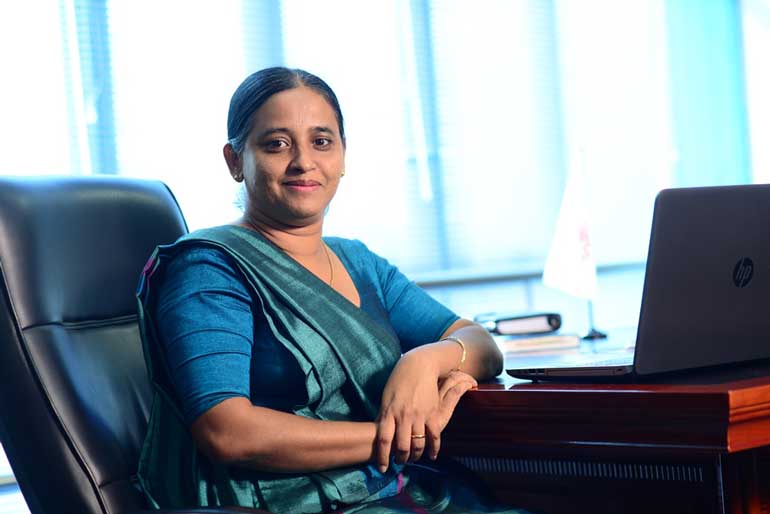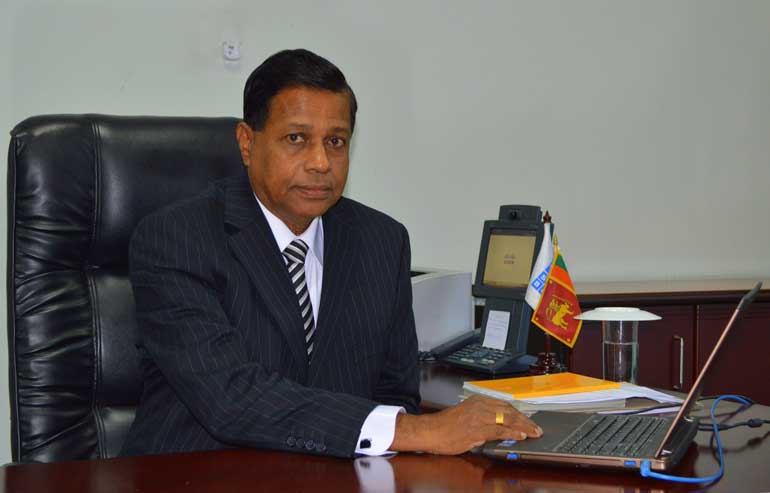Saturday Jan 11, 2025
Saturday Jan 11, 2025
Monday, 25 April 2016 00:00 - - {{hitsCtrl.values.hits}}
PBT surpass Rs. 1 b with an impressive YOY growth of 48%

SDB Chairperson Samadanie Kiriwandeniya

SDB General Manager/CEO Nimal C. Hapuarachchi
SDB posted an outstanding financial performance in 2015. The bank had a string year in terms of profitability, despite a challenging macroeconomic and regulatory environment. SDB has recorded an impressive performance with the bank’s net profit before tax surpassing the Rs.1 billion mark for the first time in history.
This is an exceptional 48% growth compared to the previous year and ended up with a post-tax profit of Rs. 720 million for the financial year ended 31 December 2015. This growth was led by interest income coupled with the responsible interest expenses management. This healthy profitability performance was recorded under challenging market conditions and it demonstrates the bank’s prudent management policies in managing the external forces.
During the year the bank increased its interest income by 36.2% and interest expense increased by only 34.9%. This resulted in net interest income of the bank growing by 37.5% to Rs. 3.3 billion, despite the banking sector margins continuing to drop in 2015. Net interest income contributed 93% to the total operating income during the year as against 86% contribution during 2014. Gross income, comprising of interest income, net fee and commission income, net gains/(losses) from financial assets held through fair value through profit and loss and other operating income recorded a 31% increase to reach Rs. 6.8 billion for the year.
Operating expenses which comprises personnel cost, depreciation and amortization and other operating expenses increased by 30.6% and posts Rs. 2.2 billion compared to the level of Rs. 1.6 billion posted in the previous financial year. The primary drivers for this growth were personnel costs and office administration and establishment expenses accounting for 46% and 21% respectively of the total operating expenses.
The growth in personnel cost was driven largely by the increased head count, taken for future expansions as well as the periodic salary revision made in June 2015. These changes have been made amidst the expected aggressive business transformation across the bank, the benefits of which will accrue over the coming years.
Although the overall operating expenses reflected an increasing trend, it is noteworthy that the cost to income ratio was controlled at 60.4% from 62.6% in financial year 2014, demonstrating the bank’s shrewd management of expenses.
Impairment charge for loans and receivables of the bank was Rs. 49.5 million and compares with a charge of Rs. 204.3 million in 2014, a decrease of 75.7% over 2014. This substantial decline represents the bank’s sound judgment in assessing the fair value of the impaired loans, based on objective evidence of future recoveries and is in accordance with its stringent risk management policies. The bank continuously makes improvement to the methodology adopted for the impairment computation process and there were no significant adjustments to the provisions as a result of such changes or improvements during the year.
Income tax including deferred tax expense was Rs. 389.9 million for the 12 months ended 31 December 2015, reflecting 58% increase over the previous year corporate income tax expense. Thus, this accounted for a 35.1% effective tax rate, a rate above the corporate tax rate of 28%. This mainly resulted from the disallowed expenses such as VAT on Financial Services (VAT on FS) and NBT. Due to the change in law applicable on VAT on FS, total VAT on FS charge for the year amounted to Rs. 229.9 million revealing 40.9% increment over the previous year’s charge.
Following to the aforesaid change leases became liable for VAT on FS and exempted from normal VAT with the removal of the exemption applied on banking and finance business. NBT expenses for the year accounted to Rs. 43.7 million as against the Rs. 27.1 million recorded in the previous year.
The bank recorded a growth of 48.6% in total assets as at the year-end over the corresponding year end. Accordingly, the total asset base reached to Rs. 60 billion marks at the end of December 2015. This growth rate is well above the average industry growth rate which is reported at December 2015 as 15.9%.
Loans and receivables net of impairment allowance grew by 43% during the year under review to reach Rs. 45.8 billion from Rs. 32.1 billion as at December 2014. The term loan portfolio saw an impressive growth during the year, representing 49.1% compared to Rs. 25.9 billion in the previous year, whilst other loan products which include leasing, hire purchase, pawning and cash margin loans grew moderately during the year under review. However, the highlight of the year was the above industry average growth in loan portfolio, which is a strong affirmation of the bank’s commitment in nourishing and nurturing the country’s growing and demanding economy.
During the year, bank’s total deposit base stood at Rs. 43 billion, representing a growth of 42.2% as against the position of Rs. 30 billion as at December 2014. Total deposit base contributed to 80.2% of the total funding base and 88.9% of the total balance sheet value.
Short term bank borrowings stood at Rs. 693.8 million as at 31 December 2015 compared to Rs. 2.9 billion in 31 December 2014 whilst long term loans increased to Rs. 5.9 billion and the debenture outstanding balance increased by 100% to Rs. 3.9 billion due to Rs. 4 billion debenture issue effected in December 2015. These steps have taken mainly due to the measures taken to reduce maturity mismatch in assets and liabilities.
Though there was no issue of new shares, shareholder funds increased by 12.8% during the year and ended up with Rs. 5.2 billion as at December 2015. Increased profitability triggered a notable increase in retained earnings, even after paying dividends and transfers to reserves. During the year in compliance to the minimum capital requirement specified by Central Bank of Sri Lanka for Licensed Specialised Banks, the bank fulfils the minimum capital base requirement of Rs. 5 billion.
Non-Performing Loan ratio of the bank improved to 2.37% as at 31 December 2015 from 3.76% as at the previous year end. It has consistently maintained its NPL ratio well below the industry average and the improvement in the NPL ratio over the preceding year is a clear reflection of rigorous recovery efforts, the prudent credit policies adopted and the continuous and consistent credit evaluation process.
The bank has long benefitted from strong bedrock of capital which has provided much stimulus in achieving solid business growth and resilience. The Tier 1 capital base of the bank was Rs. 5.22 billion, while the Tier 1 capital ratio was 12.30%. The total (Tier 1 & Tier 2) capital base of the bank was Rs. 5.41 billion as at 31 December 2015. The total capital adequacy ratio of the bank as at 31 December 2015 was 12.75%.
The bank’s statutory Liquid Asset Ratio as at 31 December 2015 was at 22.16%, which is well above the statutory minimum ratio of 20%
Commenting on the success in 2015, SDB Chief Executive Officer Nimal C. Hapuarachchi added, “2015, being a year with several political and regulatory postures being changed, which had mixed impact on the financial services sector, achieving a phenomenal growth amidst such macroeconomic challenges, affirms SDB’s position as a resilient financial institution in the market.”
Chairperson Samadanie Kiriwandeniya states that SDB is now poised for a quantum leap through a transformation process leading to a significant revenue enhancement.